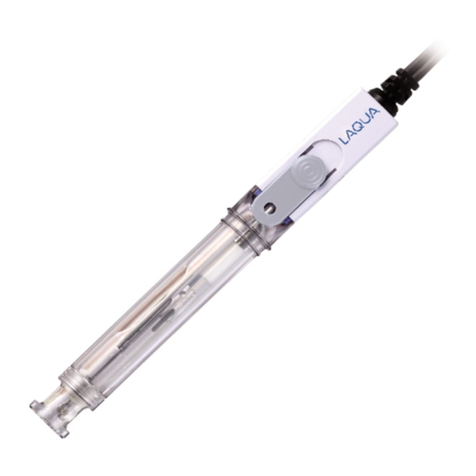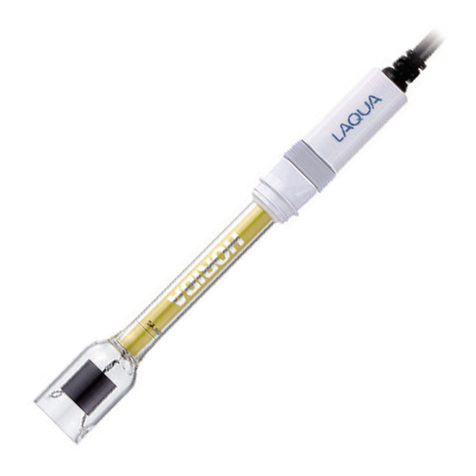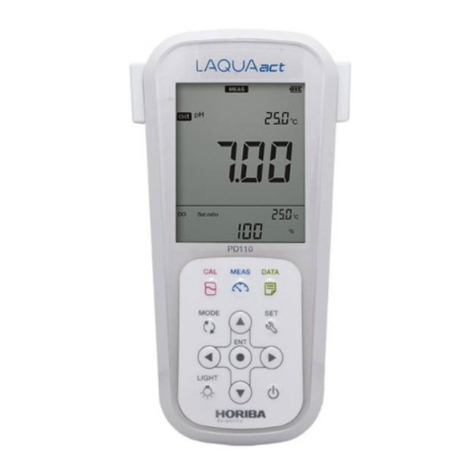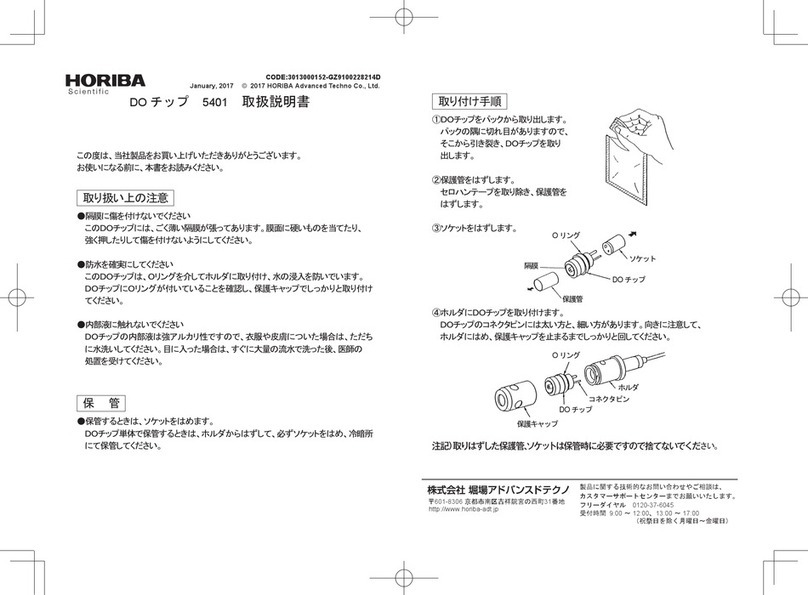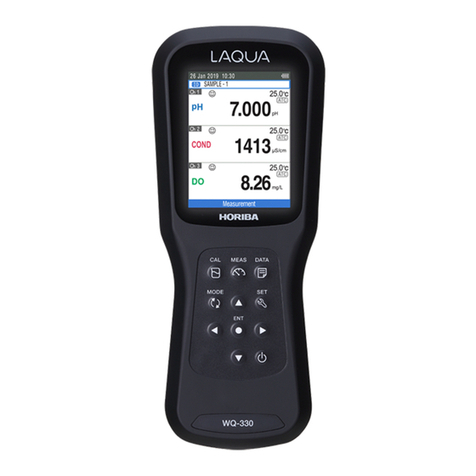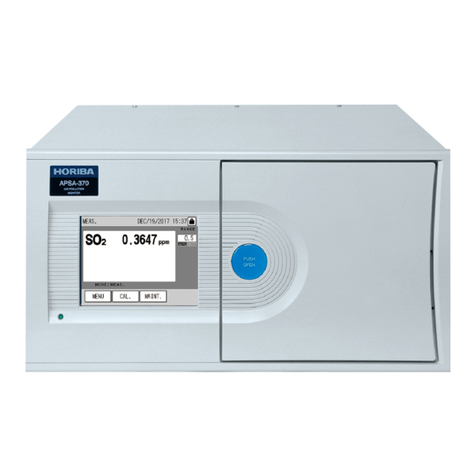
For any questions regarding this product, please contact your local agency,
or inquire from the following website.
http://global.horiba.com/contact_e/index.htm
http://www.horiba-adt.jp
31, Miyanonishi-cho, Kisshoin Minami-ku, Kyoto, 601-8306, Japan
CODE:GZ0000245920G
January, 2017
© 2017 HORIBA Advanced Techno Co., Ltd.
ISFET pH Electrode
0040-10D Instruction Manual
Thank you for purchasing a HORIBA ISFET pH electrode.
This product is less fragile and more easy to handle than
existing glass pH electrodes because of semiconductor, and
can be used with pH meters (D-10, D-20, D-50, D-70, F-10,
F-20, F-50 and F-70 series). Read this manual carefully
before use.
This is the English translation of an original Japanese
document.
Warranty and responsibility
The product (the converter excluding batteries, sensor, and
accessories) shall be repaired or replaced free of charge
should any malfunction occur during the course of normal
use if returned within the warranty period (12 months from
date of purchase). Return the converter with proof of
purchase date.
This warranty does not cover damages caused by
accidents, disasters, misuse, carelessness, and
unauthorized disassemble and remodeling.
The sole and exclusive remedy of HORIBA Advanced
Techno Co., Ltd. under this limited warranty shall be repair
or replacement of the product within a commercially
reasonable time from notification.
In any case, HORIBA Advanced Techno Co., Ltd. shall not
be responsible for customer’s passive damages, or
damages which may arise from claims instituted by a third
party against customers.
EU regulations
Conformable standards
This equipment conforms to the following standards:
Information on disposal of electrical and electronic
equipment and disposal of batteries and accumulators
The crossed out wheeled bin symbol with underbar shown
on the product or accompanying documents indicates the
product requires appropriate treatment, collection and
recycle for waste electrical and electronic equipment
(WEEE) under the Directive 2012/19/EU, and/or waste
batteries and accumulators under the Directive 2006/66/EC
in the European Union.
The symbol might be put with one of the chemical symbols
below. In this case, it satisfies the requirements of the
Directive 2006/66/EC for the object chemical.
This product should not be disposed of as unsorted
household waste.
Your correct disposal of WEEE, waste batteries and
accumulators will contribute to reducing wasteful
consumption of natural resources, and protecting human
health and the environment from potential negative effects
caused by hazardous substance in products.
Contact your supplier for information on applicable disposal
methods.
EMC: EN61326-1
Class B, Basic electromagnetic environment
RoHS: EN50581
9. Monitoring and control instruments
Warning: This product is not intended for use in industrial
environments. In an industrial environment,
electromagnetic environmental effects may cause the
incorrect performance of the product in which case
the user may be required to take adequate measures.
Authorised Representative in EU
HORIBA UK Limited
2 Dalston Gardens, Stanmore, Middx HA7 1BQ, UK
FCC Warning
This equipment has been tested and found to comply with
the limits for a Class A digital device, pursuant to part 15 of
the FCC Rules. These limits are designed to provide
reasonable protection against harmful interference when the
equipment is operated in a commercial environment. This
equipment generates, uses, and can radiate radio frequency
energy and, if not installed and used in accordance with the
instruction manual, may cause harmful interference to radio
communications. Operation of this equipment in a
residential area is likely to cause harmful interference in
which case the user will be required to correct the
interference at his own expense.
Safety precautions
Points of concern
Only use the product including accessories for their
intended purpose.
The materials used of the electrode may dissolve in the
sample depending on the specified sample or lengthy
measurement. Do not eat the whole, or the part around
where the electrode sensor touched, of measured
samples.
If measured sample gets on the skin, wash off it com-
pletely with soap and water.
Do not disassemble any parts not specified in this
manual. This may cause malfunction.
Do not touch the sensing part and sensor terminal, or It
may be damaged by static electricity.
Store the product in dry conditions. Storage area should
be kept away from high temperature, high humidity, and
direct sunlight.
Do not drop the electrode. And do not apply excessive
force to the sensor and converter.
Avoid continuous use in high temperature, acids or alkali
sample of 0.01 mol/L or thicker. Failure to comply may
cause decline life period of the sensor.
Samples containing strong reducing agents including
acidic thiourea may deteriorate the sensing part of the
sensor.
Make sure to use the electrode at a temperature within
the specified usable range (sensor: 0C to 60C,
converter: 0C to 40C).
The sensor is a consumable. If it is damaged or
deteriorated, replace a new sensor. The sensor cannot
be repaired.
White powder or solution may be generated at the liquid
junction. This is leaked internal solution of the reference
electrode, and not a symptom of trouble. Rinse the
sensor with ion-exchange water before use.
CAUTION
Handle carefully the sharp electrode tip to not get hurt.
If calibration standard solution gets on the skin, wash off it
completely. In case that the solution gets into the eyes, continue to
flush the eyes with running water for at least 15 minutes. And after
washing the eyes thoroughly, get medical help immediately.





